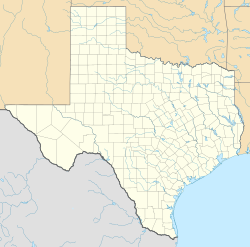History
Founded in the late 18th century, Granjeno has a history that predates Texas statehood. [5] [6] Granjeno Cemetery was established in 1872 with burials from both sides of the Rio Grande. By the mid-1930s, the community consisted of several dwellings. [7] A school established in Granjeno by 1948. Our Lady of Fatima Church was established in 1954 on land donated by Jose Concepcion Anzaldua. During the 1960s, growth in the community was stimulated by the development of a colonia. [8] The population was estimated at 545 in 1976. Ten years later, that figure had decreased to 450. On January 26, 1993, Granjeno was incorporated as a city. [5] The population was just over 300 in 2000. Mayor (Yvette Cabrera) and two commissioners (Jennifer Alvarez and Mike Cisneros) [9]
Granjeno is adjacent to the Anzalduas County Park, which is known for its moss-covered trees. Construction on the nearby Anzalduas International Bridge began in mid-2007 and the bridge became operational in late 2009. [6]
El Granjeno Cemetery (Texas Historic Landmark) was established in 1872 with the burial of Don Antonio Garza. His brother, Don Juan Garza Escheverria, donated the surrounding land for use by the communities of El Granjeno and nearby Madero. A native of Reynosa, Mexico, Don Juan (born 1854) is buried there, along with many of his descendants. Specific instructions were spelled out in historic documents that the rear of the cemetery was to be reserved only for the burial of direct descendants of Don Juan Garza Escheverria. Also interred there are veterans of the Civil War, World War I and the Vietnam War.
Cecilia Vela Zamora - Wife of Juan Garza Echeverria
A Life Rooted in El Desierto and Granjeno
Cecilia Vela, the youngest daughter of Salvador Vela and Leonor Zamora, was born on February 12, 1846. She came of age in a time of shifting borders and deep family ties. At thirty-four, she married Juan Garza, son of Matías Garza and Buenaventura Echeverría of Reynosa. Their wedding took place at El Desierto Ranch on April 30, 1880, with Amado and Carmen Vela standing as padrinos—a gesture of kinship and tradition.
Juan’s family had settled in the region shortly after the Mexican-American War, establishing El Granjeno Ranch, where they lived for decades. Together, Juan and Cecilia raised four children: Alfonso, Matías, and Francisca, whose life was heartbreakingly brief—she passed away at just five years old.
Their legacy extended beyond family. Juan and Cecilia donated land for what became the Granjeno Cemetery, a resting place for generations. Their son Matías carried the family’s spirit into public life—helping build the Mission Depot through Echeverría land and contributing to the Pacific Railroad that linked Mission and McAllen. He was also a musician and poet, blending labor with lyricism.
Cecilia passed away on June 15, 1918, and was laid to rest in the cemetery she helped establish. Decades later, on November 3, 1985, a Texas State Historical Marker was placed in her honor—a quiet but enduring tribute to a woman whose life helped shape the soul of Granjeno.
When the cemetery reached capacity, Gabriel Navarro and Ray Strawn persuaded John H. Shary, who then owned the surrounding land, to lease some land to the community. Shary did so willingly as many of his workers were Granjeno men.
Most burials are of Hispanic surnames. Among others are Guenther and Else Weiske, both born in Germany. Weiske’s brickyard in Madero provided work for Madero and Granjeno men from 1923-1973. Another is James Luke Dougherty, who taught school in Granjeno. He was county surveyor 1877, sheriff 1880-1884, and commissioner 1890-1892. Mexican Army Colonel Juan Davis Bradburn had a home there as well.
Probably the most colorful figure buried there is Sergeant Luis Ramirez of Mier. According to family tradition, he inadvertently joined the Union Army instead of the Confederate when he enlisted at Fort Brown in 1863. He served until 1866. Six of his grandsons volunteered for service in 1942. They were also descendants of Juan Garza Echeverria.
The cemetery is administered by a committee.
information courtesy of the publication, "Four Generations of Velas"
Demographics
Historical population| Census | Pop. | Note | %± |
|---|
| 2000 | 313 | | — |
|---|
| 2010 | 293 | | −6.4% |
|---|
| 2020 | 283 | | −3.4% |
|---|
|
Granjeno is part of the McAllen–Edinburg–Mission and Reynosa–McAllen metropolitan areas.
2000 census
At the 2000 census, [3] there were 313 people, 93 households and 77 families residing in the city. The population density was 896.2 inhabitants per square mile (346.0/km2). There were 107 housing units at an average density of 306.4 per square mile (118.3/km2). The racial makeup of the city was 97.44% White, 0.32% Asian, 1.92% from other races, and 0.32% from two or more races. Hispanic or Latino of any race were 99.36% of the population.
There were 93 households, of which 46.2% had children under the age of 18 living with them, 57.0% were married couples living together, 21.5% had a female householder with no husband present, and 17.2% were non-families. 17.2% of all households were made up of individuals, and 11.8% had someone living alone who was 65 years of age or older. The average household size was 3.37 and the average family size was 3.81.
33.9% of the population were under the age of 18, 10.2% from 18 to 24, 28.8% from 25 to 44, 15.3% from 45 to 64, and 11.8% who were 65 years of age or older. The median age was 30 years. For every 100 females, there were 90.9 males. For every 100 females age 18 and over, there were 80.0 males.
The median household income was $19,423 and the median family income was $19,904. Males had a median income of $16,705 and females $21,250. The per capita income was $9,022. About 40.4% of families and 51.5% of the population were below the poverty line, including 71.7% of those under age 18 and 39.6% of those age 65 or over.




